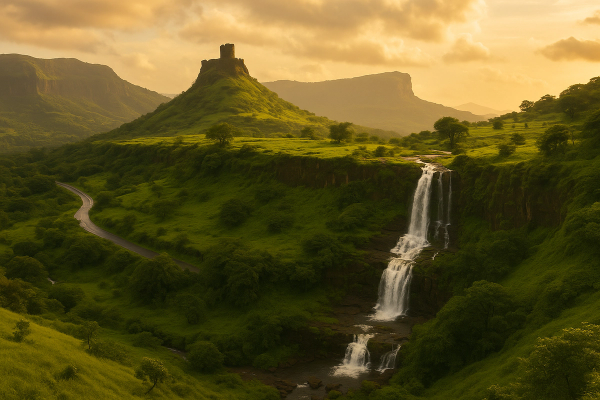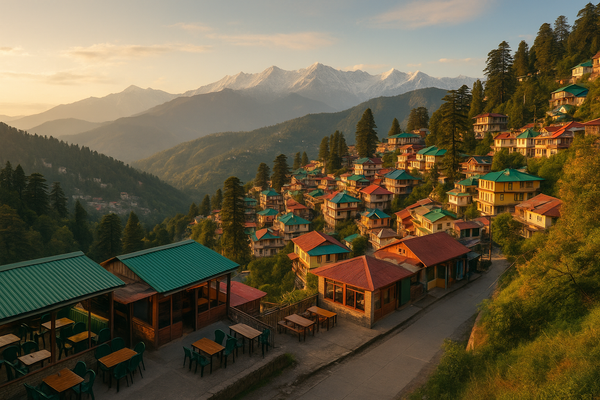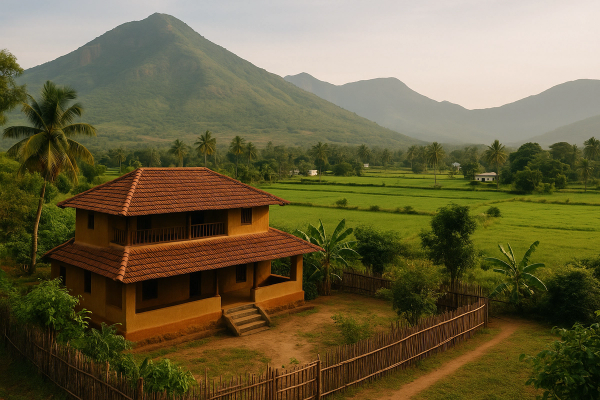Best Eco Homestays and Nature Retreats in South India – my messy, magical 2025 wanderings#
So, um, I just did this long-ish trip through South India chasing eco stays and green getaways, and it honestly felt like a reset button for my brain. I went in early 2025 because prices were sorta more stable again and trains got easier to book, and wow… coconut palms, misty hills, plastic-free breakfast tables, frogs singing at night. It wasn’t perfect—nothing ever is—but that’s kinda why I loved it. There were leeches, delayed trains, a lost sandal in Wayanad mud (rip, trusty Chaco), and a sunrise that made me cry a little, not gonna lie.¶
Why eco stays here, and why now#
I’ve been low-key obsessed with the idea of regenerative travel—like not just “don’t harm,” but actually leave a place better—and South India keeps popping up in 2025 conversations. Kerala’s Responsible Tourism Mission is super active (village experiences, community-run homestays), Karnataka’s wildlife lodges lean hard on conservation, and Tamil Nadu’s hill stations are pushing serious waste rules. Also, travel trends this year: more folks ditching short flights for fast trains, carbon-aware bookings, and stays that show where their water and waste goes. I wanted places that weren’t just green on paper but felt legit on the ground. You know, the kind of spots where they’ll hand you filtered water in a steel flask and point out the compost pit with a weird amount of pride.¶
- I wanted forest sounds not AC hums
- Treehouses. If a treehouse is involved I’m there
- Host families who’ll teach me how to make appam without judging my weird whisking
- Transparent pricing and no greenwashing—2025 has too much of that fake eco stuff
Getting there in 2025: visas, trains, timing, tiny headaches#
If you’re coming from abroad, you still need an Indian e‑tourist visa (no visa on arrival for most nationalities). Apply online and give it, like, at least a week—mine came in 3 days but a friend’s took 9. Entry’s fine through big airports in the south, like Chennai, Bengaluru, Kochi, Trivandrum. Covid restrictions are basically gone now, but carry your passport everywhere and keep digital + paper copies. Domestic folks (me and him went from Bengaluru to Kochi by train) are loving the new/expanded Vande Bharat routes—fast, comfy, you can book on IRCTC or the app, but weekends sell out fast. Monsoon season (June–Sept) still messes with the Western Ghats, so keep buffer days. Oh and 2025 heatwaves? April–May can be rough inland. Hydrate, rehydrate, then hydrate again.¶
Where I stayed and what actually felt eco (with ballpark 2025 prices)#
Pepper Trail, Wayanad (Kerala)#
Stayed in a treehouse wrapped around a jackfruit tree and woke up to Malabar giant squirrels doing parkour. The estate’s pepper, coffee, and spices are all around you—like living inside someone’s spice rack. They compost, reduce plastic, and source locally (breakfast bananas tasted too good to be legal). I paid around INR 14k/night for the treehouse in shoulder season; saw rates go up to INR 18–20k on holidays. Book a month ahead for weekends—Wayanad is hot right now. Pro tip: leech socks for the plantation walks after rain. Don’t be brave, be dry.¶
Honey Valley Estate, Coorg (Karnataka)#
Proper family-run homestay up a muddy, glorious hill. No TV, patchy signal, lots of trails. I remember stumbling into a waterfall with three other guests, all of us yelling “oh wow oh wow oh wow” like it was an incantation. They’re super mindful about waste and water, and meals are homestyle and heavy on local greens. Budget-friendly: INR 1.5–3k per room depending on the cottage. Availability swings; weekdays are easier. Bring cash—the last stretch is far from ATMs and, honestly, that’s part of the charm.¶
Kabini River Lodge (Jungle Lodges & Resorts), near Nagarhole (Karnataka)#
Old-school wildlife lodge, government linked, big on conservation ethics—safaris are proper, respectful, and the guides know when to let silence do the talking. I didn’t see a tiger (taunting me, stripes), but we had a heart-stopping wild dog sighting at dusk. Packages often include meals + safari: think INR 9.5k–18k per person per night depending on season and weekday vs weekend. Book on their official site or phone; 2025 weekends fill weeks in advance. No plastic bottles, carry your reusable. And don’t wander off paths, it’s an active wildlife corridor—elephants have right of way and, like, everything else too.¶
Spice Village, Thekkady (CGH Earth, Kerala)#
This place leans into eco with thatched roofs, organic gardens, no air-con (the design keeps it cool), and serious waste management. Periyar Tiger Reserve is right there—for the quieter bamboo rafting, do the morning slot and just listen. Rates jumped a bit in 2025’s high season; I saw INR 12–25k depending on the room and deals. The staff explained their water harvesting with the kind of nerdy joy that made me want to install a rain barrel at home. If you’re into seeing your impact, CGH Earth properties spell it out nicely.¶
Kaivalyam Retreat, Munnar (Kerala)#
A yoga-forward retreat tucked into cardamom plantations. Everywhere smells faintly peppery and green. They do veg meals, source locally, and run little nature walks that are actually good. I paid INR 7k/night including breakfast and a morning yoga session; I’ve seen festival-weekend spikes up to ~INR 10–11k. If you’re there in July–Sept, landslides can close roads—watch the local advisories and ask your host about ghat updates. Also, don’t underestimate Munnar chill. A hoodie is your best friend.¶
SwaSwara, Gokarna (CGH Earth, Karnataka)#
Regenerative wellness meets sea breeze. Long beach walks, ayurveda consults, art therapy in a studio that smelled of linseed oil and ocean. A splurge, for sure: think INR 20–35k/night or package pricing for longer stays. Minimum night requirements apply on some seasons. Sustainability is not just signage—lots of onsite gardens, low-plastic practices, and gentle staff nudges to slow down. I came for 3 nights; stayed 5 because my shoulders finally unclenched from 2024.¶
Dune Eco Village & Spa, near Auroville/Puducherry (Tamil Nadu)#
Beachside, artsy, and rough-around-the-edges in a good way. Recycled materials, quirky cottages, organic farms, and a big push on low-plastic ops. Ate one dinner under a jumble of fairy lights with a French-Tamil fusion plate that—no joke—made me text three friends mid-bite. Rates were around INR 4–9k depending on cottage. Availability was decent on weekdays, weekends more packed thanks to people driving down from Chennai. If you’re heading into Auroville for cafes/workshops, check opening hours—they do change without warning.¶
Rainforest, Athirapally (Kerala)#
Boutique lodge with straight-up cinematic views of Athirapally Falls from your room. It’s not a homestay, but they operate pretty responsibly—greywater systems, very low single-use plastic, local staff who know every birdcall by heart. I paid INR 12k for a weekday night; weekends skyrocket in season. The falls are wild in monsoon and pathways can be slippery—no flip flops unless you enjoy bruises. For birders: bring binoculars and accept that you’ll oversleep at least one sunrise because bed + waterfall white noise = spell.¶
What I actually did (and what I botched)#
Favorite memory? A dusk paddle on Periyar’s lake with a guide who kept whispering stories about old teak smugglers and how the forest took back what’s hers. Also, planting a pepper sapling in Wayanad with a farmer who said, “this one is yours,” and I’m not sure I’ve ever felt more invested in a plant I won’t see again. What I messed up: underestimating the heat in April in Kabini (bad), forgetting to prebook a second safari (worse), and not packing a decent rain jacket for Munnar (worst). Lesson learnt—South India weather in 2025 is big mood swings. Pack for all of them.¶
- Talk to your hosts. I got the best birding spots and snack recs that way
- Book wildlife safaris at least 2–3 weeks out in high season
- Slow mornings, early nights—forest lodging isn’t meant for bar-hopping vibes
- Carry a steel bottle; most eco stays refill for free and appreciate it
- Take the train when you can. 2025’s south routes are way better and kinda fun
Safety and seasonal stuff (2025 felt… normal, but pay attention)#
General safety’s fine in these areas if you use your head. Wildlife parks have rules—follow them. Don’t do the selfie-near-elephant thing, ever. Monsoon warnings are a real thing in Kerala’s hills (June–Sept) and the Nilgiris; landslides and road closures happen. Check state disaster management updates and ask your host. Heat advisories hit coastal Karnataka and interior Tamil Nadu in April–May—light clothes, electrolytes, sunblock, hat. Dengue goes up after heavy rains, so mosquito repellent and covered ankles. At night, torch + watch your step. Also, 2025’s mobile networks are better but forest patches remain patchy. It’s kinda nice. Embrace it?¶
The food (because honestly, this is half the point)#
Kerala breakfasts at homestays were silly good—appam with stew, puttu with kadala curry, banana leaf everything. Coorg gave me pandi curry and wild honey that tasted like a rainy forest. At Spice Village the chef talked about millets like poetry and I accidently ate three helpings of ragi payasam. Gokarna was fish thali heaven, though SwaSwara leans wellness so lotta fresh veg, coconut, and that calm-calm tea they brew. Eat where the hosts recommend, and try toddy once (fermented coconut sap), just to know. Sometimes it’s not good. Sometimes it’s strangely perfect with spicy fish fry.¶
“The best moments weren’t the big-ticket sights; it was the 6 a.m. quiet on a veranda, coffee steaming, a hornbill landing like a giant leaf with wings.”
Prices & booking vibes in 2025#
Good news: post-pandemic price whiplash has settled a bit. Bad news: weekends are busier than ever. Plan 2–4 weeks out for the popular eco lodges Sep–Mar. Expect dynamic pricing—holiday weeks spike. Homestays under INR 3k exist in Coorg and Wayanad if you don’t need fancy, and the nice eco resorts hover between INR 10–25k depending on the place. Packages for wellness retreats can look expensive but include meals, sessions, sometimes transfers. If a property is vague about their sustainability or pushes plastic bottles, I usually skip. Ask questions. The real eco folks will happily nerd out about their solar arrays.¶
Travel admin and tiny tips (esp. if you’re flying in)#
E‑visa still the thing for most travelers—apply early, avoid third‑party sites, print copies even if you’re paperless. No general Covid test requirements in 2025 for India arrivals, but masks in clinics or hospital visits are often recommended. If you’re hopping states by train, IRCTC app is your friend; the UTS app helps for unreserved but you’ll probs stick to reserved coaches. UPI payments are everywhere now, but carry some cash in hill towns. SIMs are easy at airports; e‑KYC is quick if you’ve got your docs. Forest entry permits sometimes need originals—ask your stay to advise. And yeah, travel insurance. Get it. I had a mild ankle sprain and was weirdly grateful.¶
Staying actually responsible (not just, like, saying it)#
Carry a reusable bottle and a little cutlery kit, don’t request fresh towels every day, and skip the random fireworks (seriously, it scares animals). Ask about greywater systems, where the food’s from, and how they handle waste. Train where you can, slow down, give your money to people doing the work—community-run village homestays in Kumarakom were a highlight for me, and booking direct put more rupees back into the right hands. Tip fairly. Don’t feed the monkeys, don’t drone in protected areas, don’t leave chai cups on moss. You’d think that last one’s obvious but… no.¶
Would I go back?#
Oh, 100%. I didn’t even do the Nilgiris tea trails properly this time, and my heart is still stuck somewhere above Kabini’s backwaters. South India does eco stays with this warm, practical sincerity—less performative, more lived. Even the imperfect bits felt good. And if you’ve got time, do a combo: one homestay (Coorg or Wayanad), one wildlife lodge (Kabini or Bandipur), one wellness retreat by the sea (Gokarna). That mix hits different.¶
If you want more stories or nuts-and-bolts planning, I keep skimming guides on AllBlogs.in between trips—nice mix of inspo and real info. See you out there, under the trees.¶














